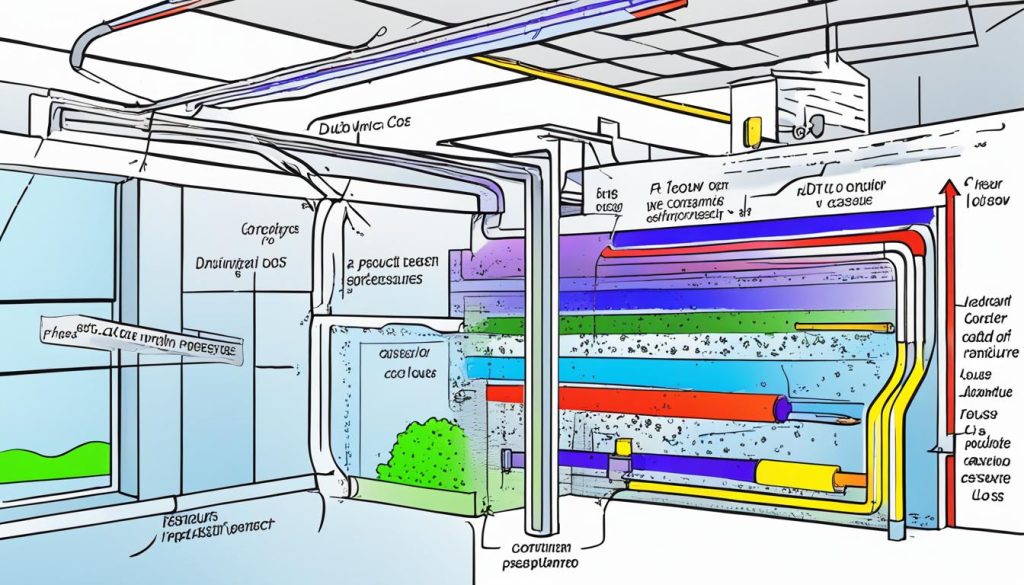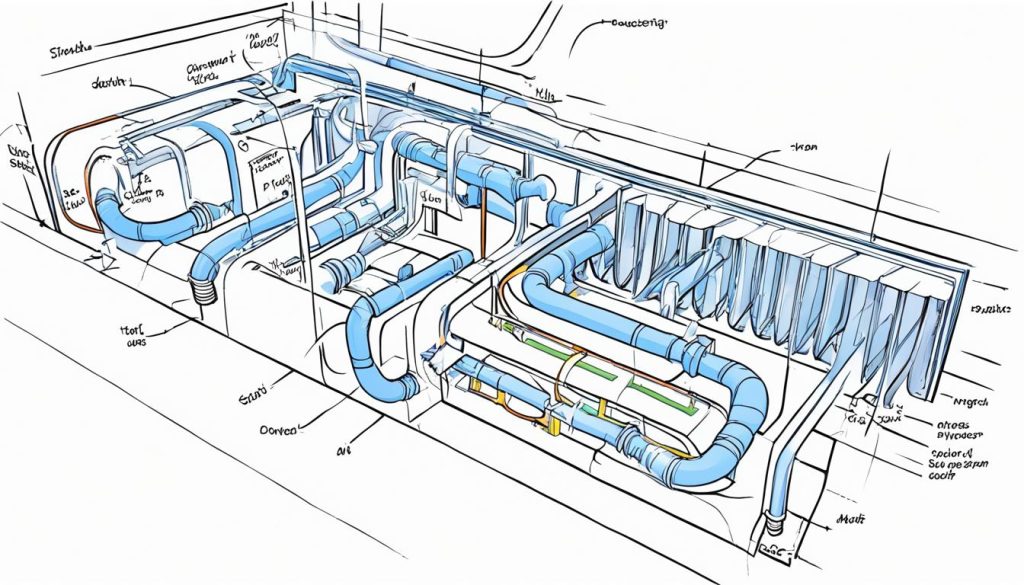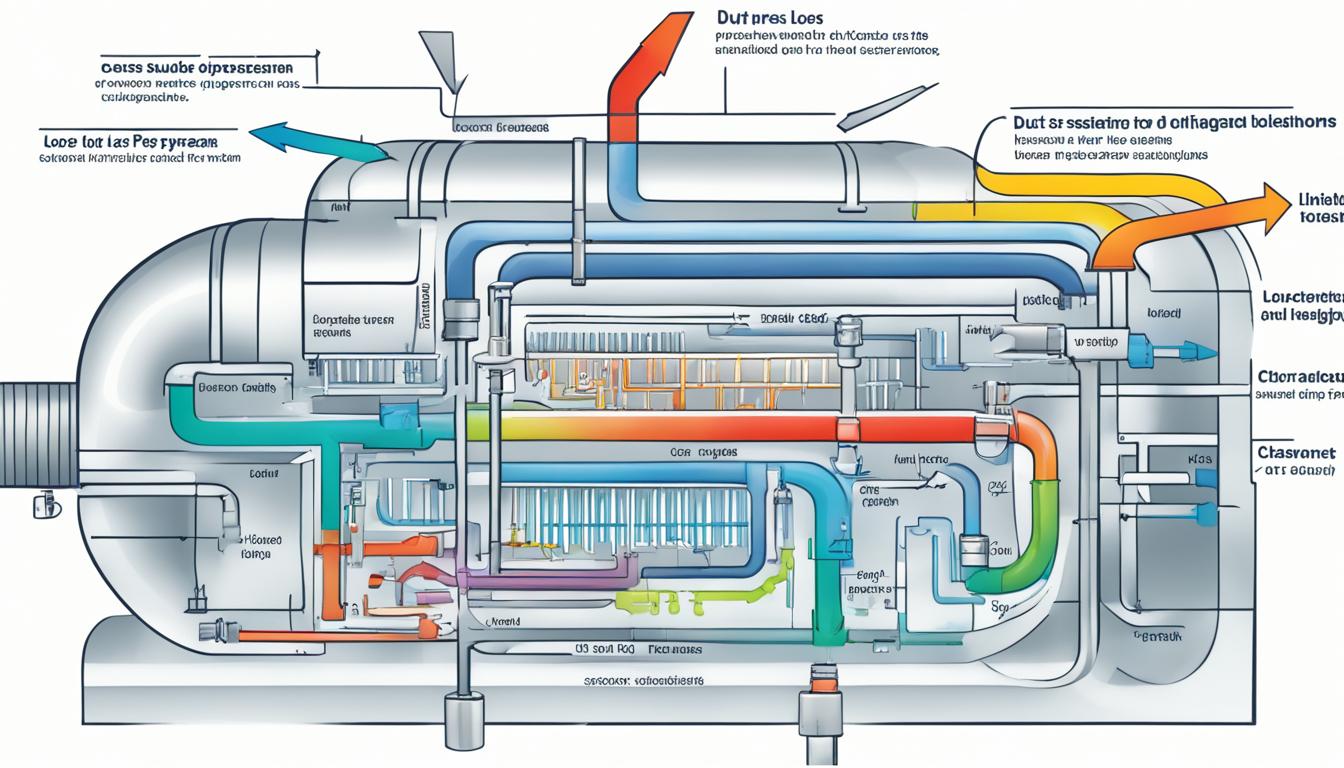Optimizing duct system performance is easy with pressure loss calculations. These are key for designing and running efficient HVAC systems. They help you figure out potential pressure losses as air moves through ducts.
Calculations look at fluid flow, velocity, and atmospheric pressure. Knowing and using these helps boost your HVAC efficiency and manage airflow better.
The formula for pressure drop is: Pressure Drop = Friction Factor * (Length/Diameter) * (1/2) * Fluid Density * Velocity². Understanding this formula and its parts is vital for better duct system performance and energy efficiency in buildings.
With pressure loss calculations, you can make smart choices about duct sizes, equipment, and system design. This knowledge leads to better airflow management and improved HVAC efficiency in your projects.
Understanding the Importance of Duct System Optimization
Duct system optimization is key to better HVAC efficiency and comfort. It helps with proper ventilation design, offering big benefits for homes and businesses.
Impact on HVAC Efficiency
Optimized ducts make sure air flows well in your space. This means less work for your HVAC, making it run better and last longer. With efficient ducts, your heating and cooling systems use less energy.
Energy Savings Potential
Optimizing your duct system can lead to big energy savings. Fixing air leaks and improving airflow cuts your energy bills. This saves money and helps the environment.
Improved Indoor Air Quality
Optimizing ducts also means better air quality inside. Good ventilation stops pollutants and allergens from building up. This makes your space healthier and more comfortable.
| Benefit | Impact |
|---|---|
| HVAC Efficiency | Reduced strain on equipment, improved performance |
| Energy Savings | Lower utility bills, reduced carbon footprint |
| Indoor Air Quality | Fewer pollutants, healthier living spaces |
Putting duct system optimization first means a more efficient, cost-saving, and comfy indoor space. The benefits are huge, from saving money to breathing easier for years.
Fundamentals of Air Flow in Duct Systems
Understanding air flow in duct systems is key to better HVAC performance. Let’s dive into the main ideas that control air movement in ducts.
Types of Air Flow: Laminar vs. Turbulent
Air flow in ducts can be either laminar or turbulent. Laminar flow means air moves in straight layers. Turbulent flow is when air moves in mixed, irregular patterns. Most HVAC systems fall between these two states.
Factors Affecting Air Flow
Many things affect air flow in ducts:
- Duct size and shape
- Surface roughness of duct material
- Air velocity
- Temperature changes
- Obstructions or bends
Bernoulli’s Principle in Duct Systems
Bernoulli’s principle is crucial for understanding duct systems. It says that faster-moving fluids have lower pressure. This is why air pressure goes down as it moves through narrower duct parts.
The Reynolds number tells us if the flow is smooth or mixed up. It’s key for figuring out friction and pressure losses in ducts.
Knowing these basics helps you make your duct system work better. This means more efficient air flow and better HVAC performance.
Introduction to Pressure Loss Calculations
Pressure loss calculations are key to making duct systems work better. They figure out how much pressure is lost in ducts and fittings. To get this, you need to know how total pressure, static pressure, and velocity pressure work together.
Total pressure in duct systems has two parts: static and velocity pressure. Static pressure is the air’s potential energy. Velocity pressure is its kinetic energy. By looking at these, you can see how to make your HVAC system run better.
When doing a pressure drop calculation, think about these important things:
- Duct geometry
- Air properties
- Flow characteristics
There are three main types of pressure losses in ductwork:
| Loss Type | Description | Impact on System |
|---|---|---|
| Frictional Losses | Caused by air friction against duct walls | Reduces overall system efficiency |
| Dynamic Losses | Result from changes in air velocity or direction | Affects airflow distribution |
| Component Losses | Occur at fittings, dampers, and other duct components | Influences system performance |
Knowing how to calculate pressure loss helps you find ways to improve your duct system. This lets you improve airflow, cut energy use, and boost HVAC performance.
Components of Pressure Loss in Duct Systems
Understanding pressure loss in duct systems is key to better HVAC performance. Air moving through the system causes pressure drops. Let’s look at the main types of pressure losses you’ll find.
Frictional Losses
Frictional losses happen when air touches duct surfaces. These losses grow with air speed and duct material roughness. You can figure out frictional losses using the Darcy-Weisbach equation for non-standard ducts.
Dynamic Losses
Dynamic losses come from air changing direction or speed. Duct fittings, bends, and transitions cause these losses. They depend on the shape of the duct parts and the dynamic pressure.
Component Pressure Losses
Some duct system parts add extra pressure drops. These include filters, louvers, dampers, and diffusers. Each part has a known pressure loss that adds to the system’s resistance.
| Pressure Loss Type | Cause | Calculation Method |
|---|---|---|
| Frictional Losses | Air friction with duct surfaces | Friction Chart or Darcy-Weisbach Equation |
| Dynamic Losses | Changes in air direction and velocity | Local loss coefficients |
| Component Pressure Losses | Physical items in the system | Manufacturer-provided data |
By looking at these pressure drop parts, you can find ways to improve your duct system. This info helps make HVAC designs more efficient and improve existing setups for better performance.
How to Optimize Duct System Performance Using Pressure Loss Calculations
Improving your duct system’s performance is key for efficient HVAC use. By doing pressure loss calculations, you can boost your system’s efficiency and cut energy costs. Let’s look at the steps to follow in this process.
Step-by-Step Calculation Process
The process of calculating pressure loss has several important steps:
- Measure duct dimensions and airflow rates
- Calculate air velocity in each duct section
- Determine the Reynolds number
- Compute the friction factor
- Calculate pressure drop for each duct section
These steps help you understand your system’s performance and find ways to improve it.
Tools and Software for Pressure Loss Calculations
Using duct system optimization tools makes calculations easier and more accurate. Some top software choices are:
- H2X: A comprehensive HVAC design and calculation tool
- ASHRAE Duct Fitting Database: Offers pressure loss coefficients for different fittings
- DuctSizer: Helps with sizing ducts based on pressure loss calculations
These tools let engineers and technicians quickly and accurately do complex calculations.
Interpreting Results for System Optimization
Analyzing your system’s performance is key to optimizing your duct system. After doing pressure loss calculations:
- Compare results to recommended values (0.5 to 2 Pa/m for commercial systems)
- Find sections with too much pressure drop
- Change duct sizes or system parts as needed
- Balance air velocity, duct size, and pressure drop for the best performance
By understanding these results well, you can make smart choices to improve your HVAC system’s efficiency and lower costs.
Duct Sizing and Its Impact on System Performance
Proper duct sizing is key to a well-working HVAC system. It’s important to find the right balance between duct size and air flow. This balance helps get the best pressure drops and energy efficiency. Let’s look at how the size of your ducts affects your system’s performance.

Bigger ducts usually mean lower pressure drops, which helps your system work better. This means air moves more easily, which can cut down on energy use. But, bigger ducts might cost more to install and take up more space.
Smaller ducts are more space-saving and might be cheaper upfront. However, they make it harder for air to move through, causing more pressure drops. This means your HVAC system might work harder, using more energy.
When picking duct sizes, think about these things:
- Available space within the building
- System requirements and capacity
- Air velocity considerations
- Budget constraints
- Long-term energy efficiency goals
By balancing these factors, you can get the best performance from your system. Remember, the size of your ducts affects your fan choice and energy use. Getting it right means your HVAC system works well, keeps you comfortable, and saves energy.
| Duct Size | Pressure Drop | Installation Cost | Energy Efficiency |
|---|---|---|---|
| Larger | Lower | Higher | Better |
| Smaller | Higher | Lower | Reduced |
When choosing duct sizes, aim for a mix that boosts system performance and fits your project needs. Think about air flow, pressure drops, and energy use. This way, you’ll get a duct system that works great and saves money over time.
Balancing Techniques for Optimal Airflow Distribution
Getting the right airflow is key to making your HVAC system work better. It makes sure you’re comfortable and uses less energy. Let’s look at some important ways to balance your duct system for better performance.
Static Pressure Balancing
Static pressure balancing means adjusting dampers to make sure the pressure is the same everywhere. This spreads the air out evenly. By checking and tweaking the pressure, you can make your system run more efficiently.
Proportional Balancing Method
The proportional balancing method is a step-by-step way to adjust airflow. Start at the branch farthest from the fan and move back. This makes sure each area gets the right amount of air. It keeps temperatures steady in different zones.
Use of Dampers and Registers
Adjusting dampers is key to fine-tuning airflow. They control how much air goes to each branch. Registers let you change airflow in specific rooms. Using dampers and registers right can fix design issues and make your space more comfortable.
| Balancing Technique | Primary Focus | Benefits |
|---|---|---|
| Static Pressure Balancing | Equalizing static pressure | Even air distribution |
| Proportional Balancing | Systematic airflow adjustment | Consistent temperatures |
| Damper and Register Use | Localized airflow control | Improved comfort |
Using these balancing techniques can really boost your HVAC system’s performance. Regular upkeep and rebalancing keep airflow even. This leads to better comfort and saves energy.
Common Pitfalls in Duct System Design and How to Avoid Them
Duct design mistakes can cause big problems with system efficiency. It’s key to know these issues to fix pressure loss. Let’s look at common errors and how to fix them in duct system design.

One big mistake is underestimating pressure drops. This can lead to poor airflow and less efficient HVAC systems. To prevent this, use precise calculations that include all parts of the system. Think about the duct length, fittings, and air speed to get the right size.
On the other hand, overestimating pressure drops is also a problem. It can cause equipment to be too big and waste energy. Do detailed pressure loss calculations to find the right balance. Don’t forget to consider local factors like temperature and altitude, which affect the system’s performance.
Ignoring how different parts work together is another mistake. Duct design errors often happen when engineers overlook how components interact. Design with the whole system in mind, not just individual parts.
- Use accurate calculation methods
- Consider all system components
- Factor in environmental conditions
- Conduct regular system inspections
- Address duct leakage and blockages promptly
Avoiding these duct design mistakes helps solve system optimization issues and reduce pressure loss. This leads to better airflow, less noise, and more energy efficiency in your HVAC system.
Conclusion: Maximizing HVAC Efficiency Through Pressure Loss Optimization
Improving your HVAC system’s performance is key for saving energy and staying comfortable. By managing pressure loss well, you can make your duct system work better. Knowing about airflow and pressure loss helps you design ducts that are efficient and cost-effective.
Getting duct sizing right is important for better HVAC efficiency. Correct sizing cuts down on pressure drops and energy waste. Using balancing techniques also boosts system performance by spreading air evenly in your building. This makes the air cleaner and more comfortable for everyone.
To get the best results, use advanced tools for figuring out pressure loss and analyzing your system. These tools help you steer clear of common mistakes and adjust your duct system. By doing this, you’ll have a duct design that saves energy and cuts down on costs.





0 Comments